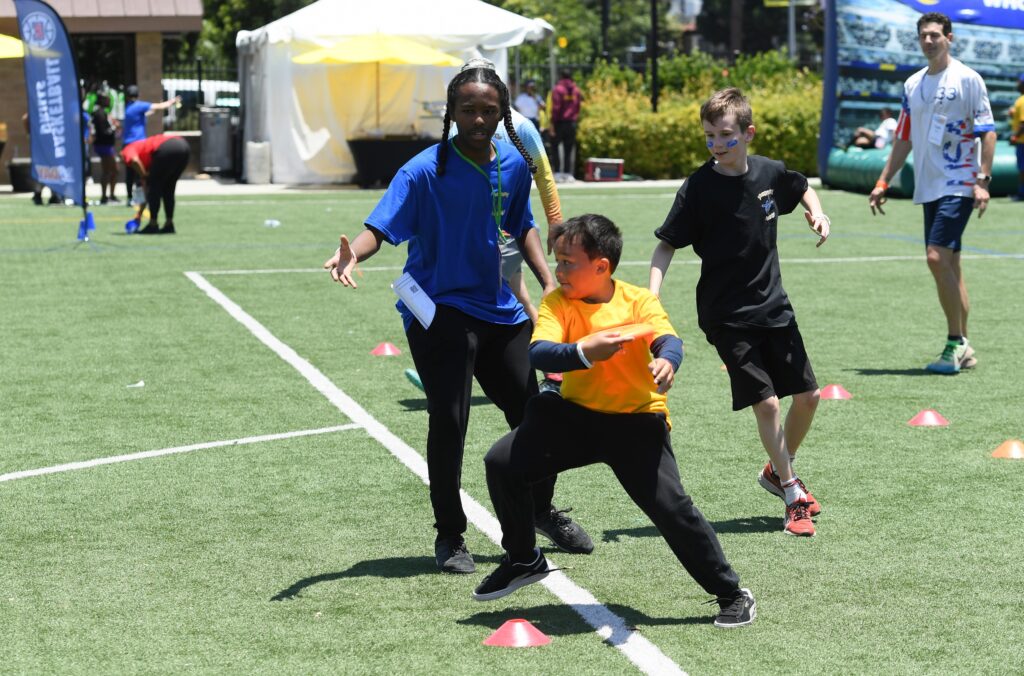
Kids get a chance to stretch their legs and skills during physical exercise in Los Angeles in 2023.
Courtesy LA84 Foundation
As California schools struggle to recover from the Covid-19 pandemic, recent headlines highlight disturbing trends: sharp increases in youth mental health crises, soaring obesity rates and widening educational disparities. Yet, an essential element of student well-being — physical education (PE) — is being alarmingly overlooked.
Across California, districts squeezed by budget pressures and testing demands are reducing or eliminating PE programs. In the San Bruno Park School District, funding cuts wiped out K-3 PE classes, leaving parent clubs to fill the gap, though two schools still went without PE.
Similarly, the San Francisco Unified School District (SFUSD), facing a $113 million budget deficit, restricted Parent Teacher Association (PTA) funds from covering staff, including PE teachers. Parents protested, fearing the loss of PE would push families to private schools.
The emphasis on standardized testing has also contributed to reducing PE programs. Under pressure to improve test scores, schools often prioritize core academic subjects over PE. This shift can lead to cuts in PE teachers and programs. This shortsighted approach neglects student health and deepens inequities for California’s most vulnerable students.
Despite California’s PE mandate — 200 minutes every 10 days for grades 1-6 and 400 minutes for grades 7-12 — compliance is inconsistent, and districts are rarely sanctioned. A study of 55 districts found that half did not meet the requirements, affecting 82% of fifth-graders, with Latino, Black and low-income students most affected. Between 2004 and 2009, audits of 188 districts revealed that half were not following the required PE minutes, yet there were no consequences for the districts.
The health consequences, however, are clear. Research shows students in districts meeting PE mandates are more likely to be physically fit. In compliant districts, 64% of students met or exceeded fitness standards, compared with 57% in noncompliant ones.
A recent study I conducted with my colleague Ruslan Korchagin revealed further disparities: 81.2% of Latino students and 81.3% of American Indian, Alaska Native, Native Hawaiian and Pacific Islander students scored below average on statewide fitness assessments. Conversely, Asian American and Filipino students (73.2%) and white students (71.3%) performed above average. Socioeconomic factors — access to nutritious food, extracurricular opportunities, and safe spaces for physical activity — drive these inequities.
The Covid-19 pandemic made things worse. California eliminated the physical fitness test in 2020. Currently, schools collect only a pass or fail for physical fitness exercises. Research from 2023 found that lockdowns significantly increased student body-mass indexes and decreased muscular strength, hitting economically disadvantaged and racially marginalized students hardest.
Physical fitness isn’t just a health issue — it’s tied to academic success. Students who exercise regularly perform better in math and reading, demonstrate stronger cognitive skills and experience lower stress levels. While regular physical activity may not directly cause these academic and mental benefits, numerous studies show a strong correlation. The California Department of Education’s data supports this: Schools with higher fitness scores tend to have better overall academic performance.
The Los Angeles Unified School District (LAUSD) is a potential model for other districts seeking to improve physical education access and quality, even with limited resources. In 2007, the district launched a plan to hire credentialed PE teachers, reduce class sizes and improve facilities. After implementation, 1 in 4 schools reported progress: smaller class sizes, more instructors and increased active time during classes. Notably, some middle and high schools even exceeded the required 40 minutes of PE per day.
LAUSD’s Blueprint for Wellness report highlights the connection between physical education and academic performance, with research suggesting physical education has improved students’ memory, concentration and cognitive function — all of which contribute to stronger academic outcomes among its students.
Gov. Gavin Newsom’s current education budget proposal presents an opportunity to address this crisis. Lawmakers must enforce existing physical education requirements across all school districts, hold public hearings to examine disparities in compliance, and include physical fitness scores in the state’s dashboard of key school performance indicators. Additionally, expanding after-school and community fitness programs in underserved neighborhoods and developing culturally inclusive, adaptive PE curricula will help ensure that all students feel represented and engaged.
California has an opportunity to lead the nation in prioritizing school fitness as a cornerstone of student success. Addressing physical education isn’t just about health. It’s about educational equity. Every child, regardless of background, deserves the lifelong benefits of quality PE. It’s time for decisive, urgent action.
•••
Da’Shay Templeton, Ph.D., is an assistant professor at California Lutheran University, a Hispanic-serving institution in Thousand Oaks.
The opinions expressed in this commentary represent those of the author. EdSource welcomes commentaries representing diverse points of view. If you would like to submit a commentary, please review our guidelines and contact us.

دیدگاهتان را بنویسید